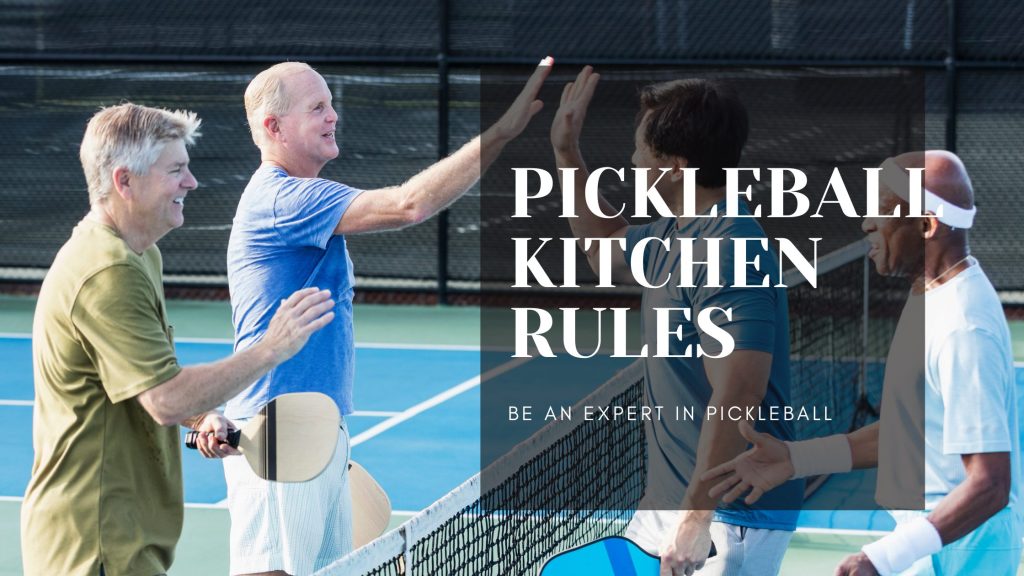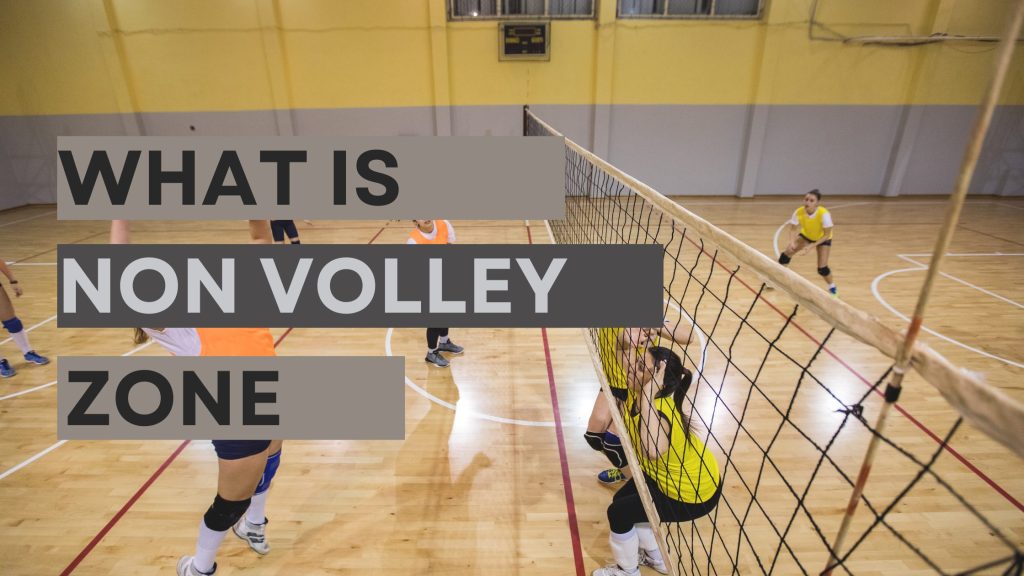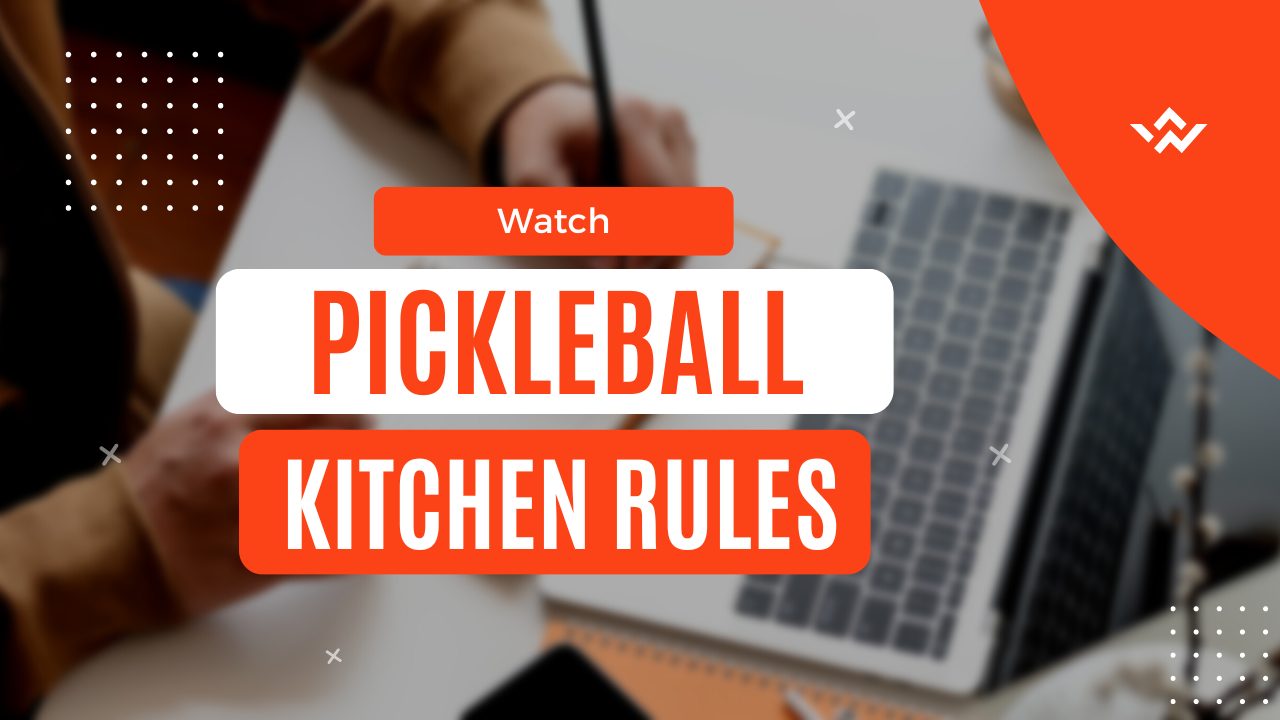The Pickleball Kitchen Rule is one of pickleball’s most famous and well-known rules. It’s easily one of the funniest things you’ll ever see, as you’ll see players in the middle of the kitchen hitting a ball out of the air.
The kitchen rule is simple. If you step into the kitchen zone, you can’t touch the kitchen line. Anything that physically connects to you counts, including your partner. Volley your momentum, and you’ll soon be landing in your favorite kitchen.
Pickleball is an increasingly popular sport that combines elements from tennis, badminton, and table tennis into one fast-paced game played with paddles and a plastic ball with holes (similar to a wiffle ball). It can be played indoors or outdoors, with two or four players competing against each other on a court similar to that used for tennis but smaller in size (typically 20’ x 44’).
As pickleball continues to grow, players need to understand the rules associated with playing this exciting game, especially those related to playing in the kitchen area near the net! This article will cover 10 essential pickleball kitchen rules about playing in the area that all players should know before they hit the court!

What is a kitchen?
In pickleball, the non-volley line is called the kitchen.
The non-volley zone is an imaginary line that runs along the baseline, which starts just beyond the net and goes around the entire pickleball court. A section of the court where the ball can’t go because it’s too close to the sidelines. This is where balls are served, and they go in from both sides of the court.
You must understand that the kitchen is the physical place, not the above area.

What is Pickleball Kitchen Rules
The kitchen is one of the most uncomplicated rules to break for beginners, but also one of the only rules unique to racket sport, so it’s a famous rule in tennis. The Pickleball Kitchen Rule states that.
The first serve of a tennis match must come from the baseline and not the net. This prevents servers from using their backhand to smash the ball at their opponent’s heads.
This will have a tremendous impact on the game of basketball. Imagine if we could play from the perimeter instead of taking free throws when fouled.
Here’s another thing to keep in mind when practicing your kitchen drills. When volleying a ball, don’t stand in the kitchen zone. A volley is when you hit the ball mid-air before hitting the ground.
Start by using a forehand volley. Once you get a feel for the stroke, try a backhand volley. Then add a cross-court volley, and finally, try a one-handed one.
Rule #1 – The Non-Volley Zone (NVZ):
The non-volley zone (also known as “the kitchen”) is an area located 7 feet from either side of the net where volleys are not allowed due to safety concerns; instead, only groundstrokes can be played within this zone on both sides of the net by either player(s). The pickleball kitchen rules momentum helps prevent situations where players could potentially hit each other with their paddles while attempting volleys near the net, which can lead to severe injuries if not properly avoided when playing pickleball!
Advantages to having this rule include increased safety while playing near the net as well as allowing more time for players to set up their shots since they must use groundstrokes rather than volleys within this zone;
Disadvantages include lower scoring potential due to less powerful shots being available when hitting groundstrokes compared to volleys near the net!
Rule #2 – Serving & Receiving:
For play to begin in pickleball, one player must serve first by hitting an underhand shot over the net that lands within their opponent’s service box; once served successfully, then it’s up to their opponent(s) to return it over without hitting any part of their body or clothing first before making contact with their paddle (this is known as “double-hitting” which results in a fault)!
Additionally, there are specific requirements when serving, such as having at least one foot behind either baseline when starting your serve motion and keeping your paddle below your waist during said motion; failure to adhere to these rules will result in a fault being called against you!
Rule #3 – Scoring System:
Pickleball utilizes different scoring systems depending on whether you’re playing singles or doubles games; for singles play, each point scored is worth 1 point regardless if you win or lose that particular rally, whereas doubles games utilize an 11-point scoring system where points are only awarded after winning rallies (this means that you can still lose points even if you won them during previous rallies!).
As such, it’s essential for all players involved in pickleball matches/games, no matter what type they’re participating in, so understand how points are awarded accordingly!
Rule #4 – Let Serves:
Let serves occur when either player fails to return an incoming serve within 3 seconds after contact has been made between both paddles; if this happens, then no point is awarded, and instead, another serve must be attempted by whoever was initially serving until one side manages successfully return it over without faulting again (this process repeats itself until someone manages to do so correctly)!
This rule helps keep games moving along at a consistent pace since there’s no need to waste time waiting around for someone who may have difficulty returning serves quickly enough due avoid double-hitting faults occurring too often!
Rule #5 – Volleying On Your Side Of The Net:
Volleys are allowed on your side of the court provided that you don’t hit any part of your body or clothing first before making contact with your paddle; additionally, any volley made outside the non-volley zone still counts regardless if it lands inside or outside said zone provided that all other rules have been followed correctly beforehand!
This rule helps keep gameplay fair since both sides can still benefit from using volleys strategically, even if they’re limited within proximity towards the net due to safety concerns associated with doing so otherwise!
Rule #6 – Faults In Pickleball:
Faults occur whenever players fail to adhere to specific rules associated with playing pickleball, such as double hits/carry-overs (which happens when someone touches the ball twice consecutively), foot faults (when serving), etc.; these faults result in immediate loss point regardless who was originally responsible committing them unless specified otherwise beforehand!
It’s essential to know what constitutes a fault, so everyone knows what to expect while playing a game, which ultimately helps create a more enjoyable overall experience for everyone involved!
Rule #7 – Double Hits And Carry Overs :
Double hits occur when someone touches the ball twice consecutively without letting go paddle between contacts; carryovers happen after ball has bounced twice off same person’s paddle without anyone else intervening between bounces!
These faults result in immediate loss points unless specified otherwise, so it’s essential to be aware of these regulations to ensure fair gameplay throughout the match!
Rule#8 – Foot Faults :
Foot faults occur whenever the server steps into the service box before releasing the ball during service motion; this type of fault results in an instant loss point unless specified otherwise! It’s essential to stay own aware of feet during serves to avoid committing foot faults unintentionally!
Rule#9 – The Kitchen Line :
The kitchen line refers boundary line located 7 feet away from the centerline, which divides the court into two halves; any shots made across the kitchen line count regardless if they land inside or outside non – the volley zone!
This rule keeps gameplay fair since both sides can still benefit from using powerful shots strategically even though they’re limited within proximity towards the net due to safety concerns associated with doing so otherwise!
Rule#10 – Timeouts :
Timeouts allow either team to take a break during match order, regroup, discuss strategy, rest, etc; timeouts typically last 30 seconds but may vary depending on tournament/league guidelines established beforehand!
It’s essential to know how to request timeouts to avoid wasting precious time during the match while also ensuring everyone present understands what happens once the timeout ends!
FAQs
Final Verdict
understanding essential pickleball kitchen rules about playing near the kitchen area will help ensure everyone enjoys safe, fair, competitive matches every time they step onto the court! Knowing these regulations beforehand allows participants to prepare themselves accordingly before beginning play, leading to smoother transitions throughout the game!
By following the guidelines mentioned earlier, hopefully, everyone involved will have a more enjoyable overall experience while also learning important lessons about sportsmanship along the way!

